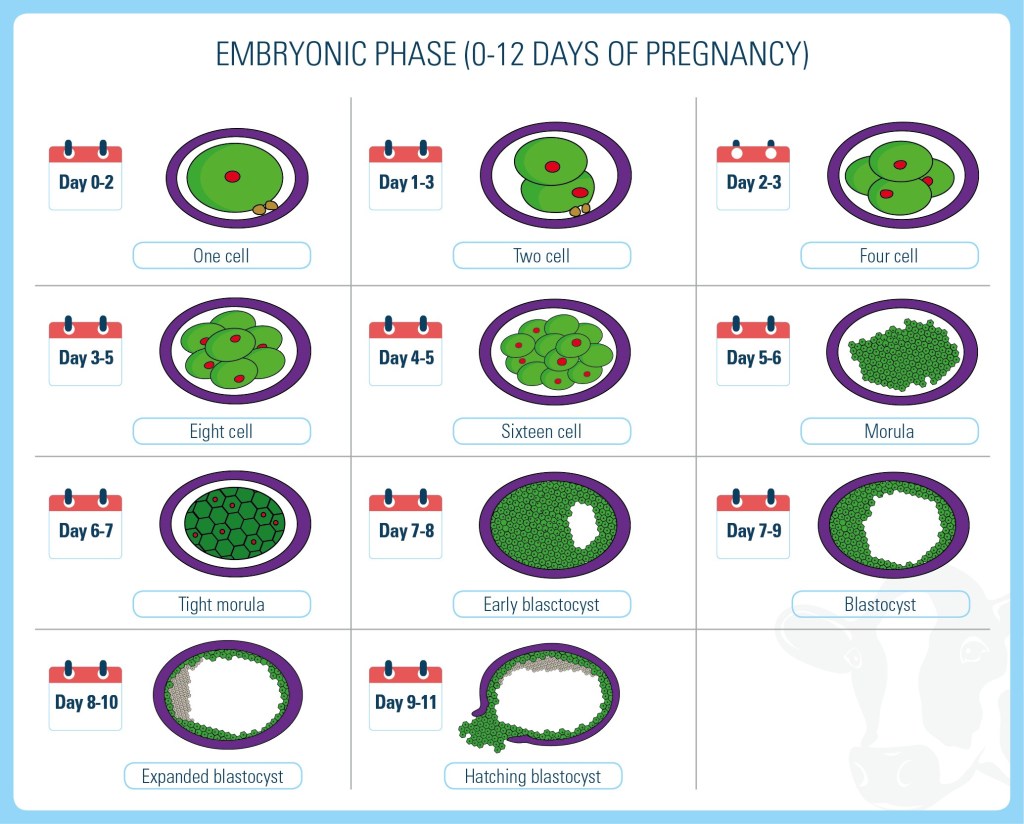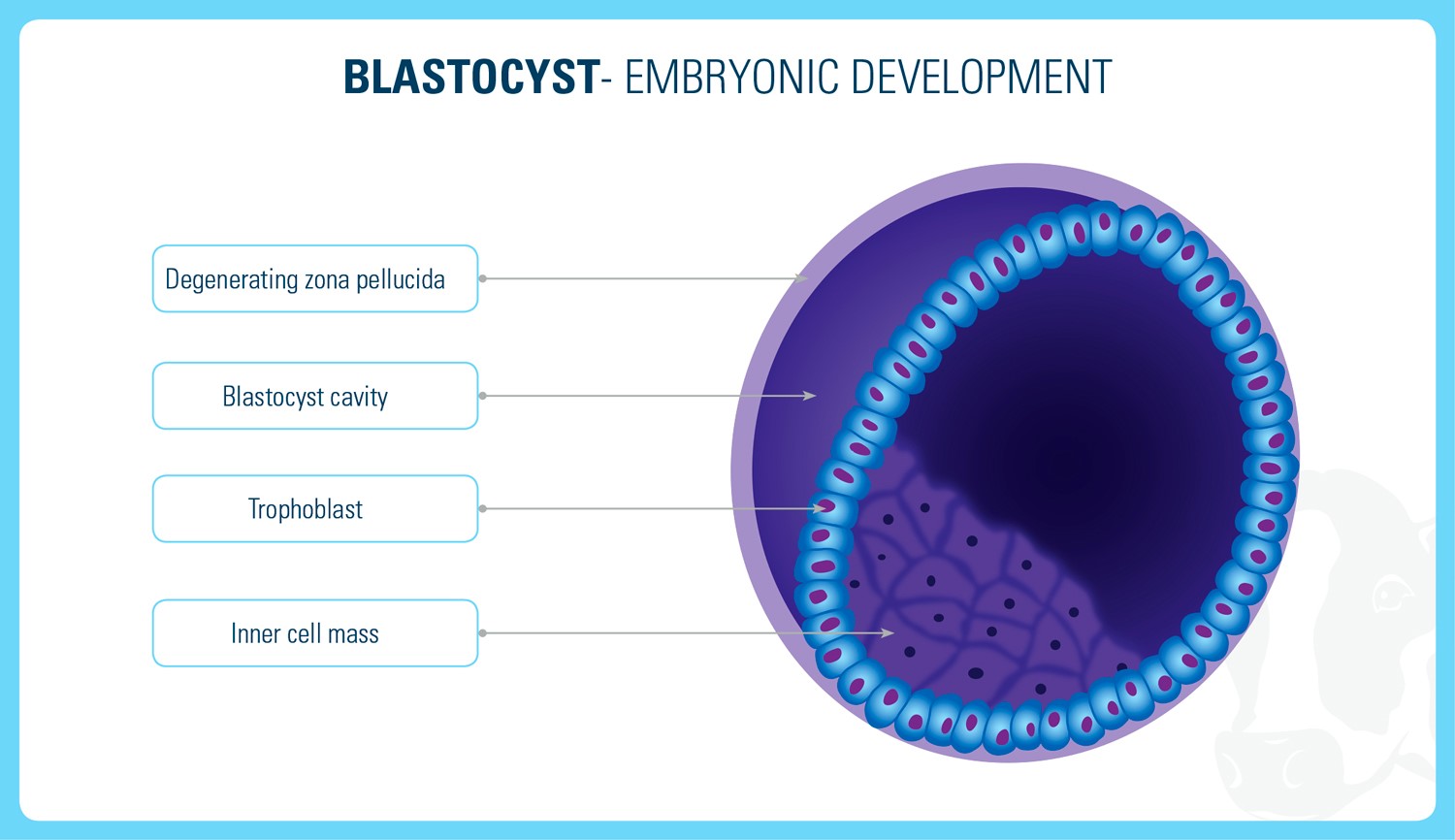

Pregnancy & Diagnosis
Fertilization of the ovum (oocyte) takes place in the oviduct. The blastocyst arrives in the uterus around day 5.
Gestation in cattle lasts 280 days on average, spanning 279-290 days.
- Embryonic phase:

- Fetal phase:
Proper corpus luteum function ensures sufficient levels of progesterone, which is essential for maintaining pregnancy.
The developing embryo produces and releases interferon-T (INF-t)1, a specific signal to prevent luteolysis and maintain pregnancy. The luteolysis inhibition mechanisms are:
- Inhibition of oxytocin receptors on the uterine luminal epithelium
- Induction of a prostaglandin synthesis inhibitor

In cattle interferon-T synthesis molecules are detected on the outside of the trophoblast around day 12.
Maximum interferon-T levels are reached between days 15 and 161.
Failure of Pregnancy Recognition
Insufficient or delayed INF-t production occurs when:
- Embryonic development is slowed
- Embryonic growth and the progress of the maternal estrous cycle are not synchronous due to delayed ovulation or late insemination
Importance of Early Luteal Function in Pregnancy Recognition
A possible reason for pregnancy failure is the cow having low progesterone concentrations early in the cycle. Studies have shown that cows that fail to maintain pregnancy have lower concentrations of progesterone in milk and plasma2.
The degree of embryo development is closely related to the maternal progesterone environment. Cows with poorly developed embryos on day 16 after the first insemination that produced little or no INF-t exhibited both a delayed increase in progesterone concentrations after ovulation and had a lower progesteron concentration during the luteal phase than cows with well-developed embryos3.
Early identification of nonpregnant cows post-breeding improves reproductive efficiency and pregnancy rates in cattle by decreasing the interval between AI services, therefore increasing the AI service rate.
Direct Methods for Early Pregnancy Detection
These involve direct detection of the tissues and/or associated fluids of the conceptus either manually or via electronic instrumentation4.
The following affect the sensitivity and specificity of direct method testing:
- Technical expertise
- Operator proficiency
- Stage post-breeding
- Transrectal palpation
- Easiest, fastest, cheapest and most accurate method
- 95% accurate
- Occurs between 35 and 65 days post breeding
- Allows an estimate for the stage of the pregnancy
Common reasons for error in rectal palpation
- Failure to retract the uterus
- Abnormal uterine contents (pyometra or mucometra)
Safety
- Widely used, generally safe method for pregnancy diagnosis in cattle
- Early or inappropriate palpation of the amniotic vesicle may damage the embryo and cause embryonic mortality
Early pregnancy diagnosis (1-3 months)
Based on a combination of:
- Asymmetry of the uterine horns
- Decrease in the tone of the pregnant horn
- Fluctuant contents in the pregnant horn (later both horns)
- A palpable corpus luteum on the ovary on the same side as the pregnant horn
Diagnosis in later pregnancy (>3 months)
- Cervix is located anterior to the pelvic rim and the uterus cannot be retracted
- Uterus is flaccid
- Placentomes, and sometimes the fetus, are palpable
- The median uterine artery increases in diameter and fremitus can be detected
- Ultrasonography
A real-time/B-mode ultrasound is a reliable, relatively simple method that can diagnose cattle pregnancy as early as day 26.
Ultrasonography shows over 99% accuracy and can detect early embryonic loss much earlier than can rectal palpation.
Conceptus characteristics visible via ultrasound
Table 1. Day of first detection of ultrasonographically identifiable characteristics of the bovine conceptus. Adapted from Curran et al. (1986).

- Doppler ultrasonography
- Allows for a more detailed assessment of the uterus, ovarian follicles and corpus luteum
- 98.5% accuracy in predicting non-pregnant females at 20 days after TAI
- 64.8% accuracy in predicting pregnant females at 20 days after TAI
Indirect Methods
These use qualitative or quantitative measures of cattle reproductive hormones at specific stages after AI or detect conceptus specific substances in maternal body fluids as indirect indicators of the presence of a viable cattle pregnancy.
- Measurement of cattle endocrine hormones such as progesterone
- Cattle progesterone secreted by a functional corpus luteum between 18 and 24 days after service or insemination is an early pregnancy indicator
- Can be assayed in milk or plasma
- Optimal assay time is 24 days after service or AI
Accuracy
- Sensitivity (accuracy in cattle pregnancy detection) of the cow-side milk progesterone (EIA) test was 93.1% in a study by Pieterse et al. (1989)
- Specificity (accuracy in detecting non-pregnancy) was only 39.3%
- A large number of nonpregnant cows may thus be diagnosed as pregnant
Common reasons for errors in hormone measurements
- Pyometra/persistent corpus luteum
- Short estrous intervals
- Cystic ovarian disease (luteal cysts)
- Incorrect handling of the samples and test kit
- Cattle estrone sulphate
- Conjugated estrogen produced specifically by the conceptus
- Also present in milk and plasma of nonpregnant animals
- Concentration increases as pregnancy advances
- Cattle pregnancy-associated glycoproteins (PAGs)
- Large family of glycoproteins that increase from 15 to 35 days of gestation
- Variation between cows in serum PAG levels limits their use as a reliable pregnancy indicator until 26-30 days of gestation
- Early pregnancy-associated protein (ECF)
- Tests to detect ECF in blood samples within 48 hours of conception
- Should be treated solely as an indication of conception due to high incidence of embryonic mortality
- Pregnancy should later be confirmed by rectal examination or ultrasound
- Interferon-tau (IFN-t)5
- Novel type I interferon
- Embryo produces it in large amounts after day 14
- Research in early pregnancy diagnosis
Current research is focused in5:- New markers of pregnancy detection:
Serum pregnancy associated glycoprotein (PAG). In a recent study by Pohler in 2016, concentrations greater than 1.39 ng/mL at day 24 were 95% accurate in diagnosing a pregnant heifer. - The ability to predict and detect pregnancy loss or failure: Both PAG and miRNA data suggest that embryo loss can be predicted using these biomarkers.
Circulating microRNAs
Potential biomarkers of pregnancy diagnosis. Found in biological fluids ranging from serum and amniotic fluid to urine and milk.
- New markers of pregnancy detection:
Visual Methods
- Nonreturn to estrus
If estrus signs are not observed around three weeks after service or insemination, the cow is generally assumed to be pregnant. However, even if estrus detection is good, not all of these cows will be pregnant.
On the other hand, up to 7% of pregnant cows will show some signs of estrus during pregnancy. Insemination of these animals may result in embryonic or fetal death. - Metaestrous hemorrhage
Bloody vaginal discharge in cows 24-48 hours after estrus. If metestrous bleeding is observed in a cow that was not seen in estrus a few days prior, it is implied that estrus was unobserved, and the animal is not pregnant. - Exposure to a bull or artificial insemination
Observing mating or artificial insemination is an obvious visual clue to predicting cattle pregnancy, but it is not a reliable indicator of pregnancy status.
- Mann GE, Lamming GE. 1999. The influence of progesterone during early pregnancy in cattle. Reproduction in Domestic Animals 34
- Starbuck M, Dailey R, Inskeep K. (2004). Factors affecting retention of early pregnancy in dairy cattle. Animal reproduction science. 84. 27-39.
- Mann GE, Lamming GE. 2001.Relationship between maternal endocrine environment, early embryo development and inhibition of the luteolytic mechanism in cows. 2001. Reproduction 121(1):175-180.
- Bekele N, Addis M, Abdela M, AhmedWM. 2016. Pregnancy Diagnosis in Cattle for Fertility Management: A Review Global Veterinaria 16 (4): 355-364.
- Pohler KG, Franco GA, Reese ST, Dantas FG, Ellis MD, Payton RR. 2016. Past, present and future of pregnancy detection methods. Applied Reproductive Strategies in Beef Cattle. September 7-8.

